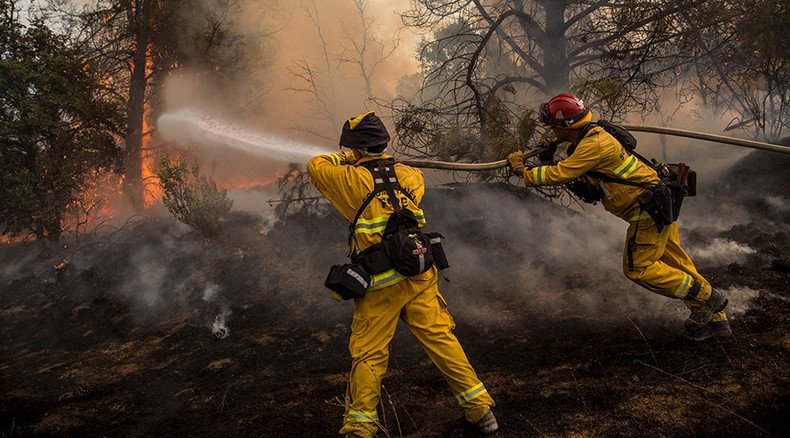50% of Forest Service budget going up in flames fighting wildfires – report

With firefighters battling 22 wildfires in California, a US Forest Service report shows that half its annual budget is allocated to fighting wildfires. Those costs are expected to balloon to nearly $2 billion by 2025 unless Congress makes changes.
The Forest Service and its partners have fought more than 36,000 fires this year alone. While the agency is successful at fighting 98 percent of the fires when they start, one to two percent of fires that escape become expensive and eat up 30 percent of the agency’s budget, according to the report.
"Climate change and other factors are causing the cost of fighting fires to rise every year," said Agriculture Secretary Tom Vilsack in a statement, "but the way we fund our Forest Service hasn't changed in generations. Meanwhile, everything else suffers.”
READ MORE: ‘Jaw-dropping’ California wildfire fueled by drought, winds
Covering those costs often requires the transferring of money allocated for other areas such as forest restoration activities, which are designed to help reduce the threat of catastrophic fires, according to the report.
The agency also budgets firefighting costs based on a 10-year rolling average. For the first time in its 110 year history, 52 percent of the Forest Service budget is going to address wildfires, compared to just 16 percent in 1995. That has meant a loss of $700 million to spend on other agency work.
FACT: We've seen a 39% loss of non-fire staff @ForestService. Fire staff has more than doubled http://t.co/VLFxqIvjEGpic.twitter.com/GSWoMLTLHi
— Dept. of Agriculture (@USDA) August 5, 2015The Forest Service manages more than 600 million acres of national and private forests, as well as grasslands, in 43 states and Puerto Rico with a budget of $4.9 billion.
Unless reforms are made, the agency could devote 62 percent of its budget to fighting wildfires by 2025.
Compounding this problem is how Congress has traditionally funded the agency.
The agency is allocated a budget to fight wildfires along with other work because Congress doesn’t treat wildfires as natural disasters, for which lawmakers can suddenly allocate emergency funding. This method has worked for over 100 years, but wildfires are different in 2015.
The agency’s budget dilemma is being thwarted as the fire season lasts longer. It’s now as many as 300 days in some parts of the country, and the frequency, size and severity of the fires has increased.
A changing climate has also meant new regions are experiencing wildfires that were not “historically prominent,” according to the report.
REPORT: Rising cost of wildfire means @ForestService budget is at a tipping point → http://t.co/PikJVZ0Wlw#FireFixpic.twitter.com/5TQXEyoUfJ
— Dept. of Agriculture (@USDA) August 5, 2015Urban sprawl is another contributing factor, with homes built nearer to forests, a development which adds complexity for firefighters who have to not only battle flames but also save lives and protect property.
Last year alone, the 10 largest wildfires cost the government more than $320 million, the report said, and it's only expected to get worse.
There might be a solution with the Wildfire Disaster Funding Act, bipartisan legislation already introduced into the House and Senate that would treat wildfires more like natural disasters, end transfers between budget line items, and replenish the agency’s capacity to restore resilient forests to protect against future fires.
READ MORE: 18 raging wildfires force California Gov. to declare state of emergency
Under the bill, the fires which currently eat up 30 percent of the Forest Service’s annual costs could access disaster funding. Such reform could also ensure there is sufficient money budgeted for watershed projects to protect drinking water, recreation projects, and billions of dollars of economic activity and protection for precious cultural resources and wildfire habitats.
“Unfortunately, due to Congressional inaction and growing costs associated with fighting wildfires, the Forest Service is increasingly turning into a firefighting agency,” Senator Jon Tester (D-Montana) said in a statement on Thursday, reported the Hill.
Eleven other senators are furious about the situation and released similar statements supporting the act.












